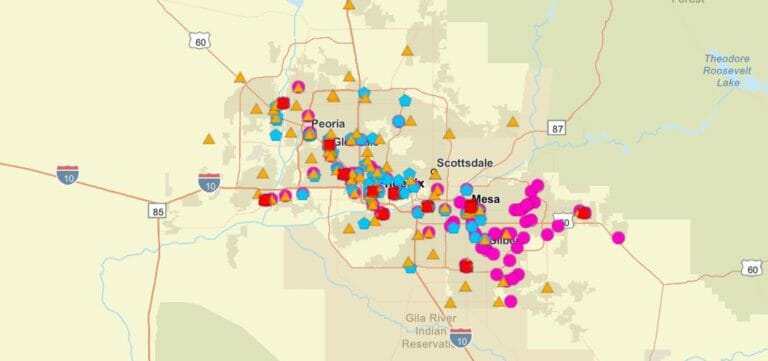Have you ever experienced the blistering heat of a summer afternoon in Arizona? Did you have water, shade, or air conditioning to provide heat relief and help cool you down? Unfortunately, there are Arizonans experiencing extreme heat that do not have consistent access to air conditioning or water, which can result in heat-related illness or even death. The recent COVID-19 pandemic has made finding heat relief even harder, but thanks to the collaboration of many Arizona partners, the Heat Relief Network continues to serve those in need during the hot summer months.
In order to increase vulnerable populations’ access to heat relief, the Maricopa Association of Governments (MAG) coordinated a state-wide effort starting in 2005 called the Heat Relief Network. In 2020, the AZ Heat & Resilience Workgroup and the Arizona Faith Network joined the Heat Relief Network.
In 2019, before the COVID-19 pandemic, there were 106 registered, indoor, air-conditioned cooling centers operating in the Valley. In 2020, there were 19. Tina Lopez, Administrative Assistant in the Human Services Division at MAG, said it was an “incredible loss.” Though that number has since increased to 95, a large gap remains. The difference in heat relief provided over the past three years can also be seen in MAG’s website data. Their interactive cooling center map has been viewed 11,663 times during the summer months of May, June and July this year. In 2020, the map was viewed 10,378 times from May through September. In 2019, the total views were significantly higher at 67,628 from May through September of that year.

Cooling centers that remained open experienced challenges in operating during the pandemic. Some locations saw reduced donations that made providing water or snacks difficult, while others dealt with maintaining social distancing during peak hours and enforcing masks. Mandy Porter-Griffith, Case Manager and Outreach Director at Salvation Army Metro Phoenix, reports that despite COVID limitations the Salvation Army Phoenix has served an incredible 25,555 people and handed out 67,175 water bottles as of Aug. 3, 2021.
“The pandemic has seen more people out of work, which means more are coming to The Salvation Army for things like emergency food boxes, family shelter, rent and utilities assistance, and more,” said Major David Yardley, the Salvation Army Metro Phoenix Program Coordinator.
Salvation Army is one of many partners that work together to provide heat relief, including non-profits, St. Vincent de Paul, the Arizona Faith Network and 2-1-1 Arizona.
“Our partners at Arizona Faith Network have provided an additional 14 cooling centers this summer in the highest need locations,” said Melissa Guardaro, an assistant research professor at ASU with Healthy Urban Environments (HUE) and Knowledge Exchange for Resilience (KER). Guardaro also leads the AZ Heat & Resilience Workgroup’s newly formed Cooling Center Subgroup.
“The creation of the Cooling Center subgroup helps to focus solely on providing cooling centers, rather than other aspects of heat relief,” said Guardaro. “As a result, we are taking a deep dive into improved communication at the grassroots level, provisioning for cooling centers, especially new locations, polling cooling center operators to learn more about operations, and ensuring the accuracy of information available on various web platforms.”
Braden Kay, Sustainability Director at the City of Tempe, said that the subgroup “is developing best practices, attracting funding and resources and developing a culture of strategically located and well executed cooling centers across the region and state.”
“It’s important for all Arizonans to know that they have a public space they can go in the event of a power outage or extreme heat crisis,” said Kay.
Guardaro said that the Cooling Center Subgroup has “received generous support from APS and SRP, as well as the Arizona Lottery.” Guardaro also notes that volunteers who staff the cooling centers have been provided by the Arizona Governor’s Office through Americorp volunteers, and local organizations including Just Serve and Hands On Phoenix.
The Maricopa Association of Governments (MAG) created the Heat Relief Network in response to a weeklong heatwave in 2005 that killed 30 people experiencing homelessness. MAG’s role is to coordinate the regional mapping of cooling centers, hydration stations, donation sites and emergency hydration stations in the Valley with the intention of reducing heat-related illness and death and creating a community of aid.
A cooling center is a location where a person can seek heat relief and water while a hydration station only provides water. An emergency hydration station does provide both a place for heat relief and water, though they are only open during extreme heat events. MAG’s interactive map allows users to find each kind of location throughout the Valley and includes the organization name, hours of operation, address, contact information.
The ASU Sustainable Cities Network (SCN) is an innovative education and outreach program within the Julie Ann Wrigley Global Future Laboratory, created to work with communities to strengthen sustainability in the region and across Arizona. Comprised of Arizona city, town, county and tribal community practitioners and leaders, SCN is a vehicle for sharing knowledge, identifying best practices, coordinating planning and actions, and fostering long-term partnerships. Created as a bridge between ASU research and local sustainability challenges, SCN participants and partners work together to streamline and green city operation and advance local and regional sustainability and resilience measures.
